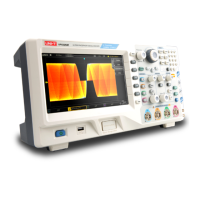23
Polarity:
Press the polarity key to select the trigger polarity: positive and negative.
(1) Positive: Set to trigger on the positive runt pulse.
(2) Negative: Set to trigger on the negative runt pulse.
Trigger Setting:
Please refer to the Trigger Setting in the “Edge Trigger” section for more details.
Condition:
Press the condition button to select the condition: None, >, <, =.
(1) None: Does not set the runt pulse trigger condition.
(2) >: Triggers when the runt pulse width is greater than the set pulse width.
(3) <: Triggers when the runt pulse width is less than the set pulse width.
(4) =: Triggers when the runt pulse width is equal to the set pulse width.
Setting:
Press the PgDn key and adjust the Multipurpose knob (shuttle knob or
numeric keypad) to set the time.
Trigger Level:
Press PgDn trigger level to select low level or high level. You can also
directly press the LEVEL knob in the trigger control area to quickly switch
between selections.
(1) Low level: The low level of the runt trigger can be adjusted by the LEVEL
knob.
(2) High level: The high level of the runt trigger can be adjusted by the LEVEL
knob.
5.7 Window Trigger
Select the window trigger, its trigger level has a high level and a low level.
The oscilloscope triggers when the rising edge of the input signal crosses
the high level or the falling edge crosses the low level.
Press TRIG MENU type, and select window by the Multipurpose knob.
You can also switch the trigger type by consecutively pressing the type key,
then press the Multipurpose knob to confirm.
At this time, the trigger setting information is displayed at
the upper right corner of the screen, the trigger type is window, the trigger
source is CH1, and the low level of the trigger level is 124mV.
Window Trigger Menu
Source:
Press the source key to select the source, you can select CH1, CH2, CH3,
and CH4. The currently selected source is displayed at the upper right corner
of the screen.
Note: Only selecting the channel with connected signals as a trigger source
can obtain a steady trigger.
Slope:
Press the slope key to select which slope the input signal will trigger on, you
can select the rising edge, falling edge, and any edge. The currently slope
type is displayed at the upper right corner of the screen.
(1) Rising edge: Triggers on the rising edge of the input signal and when the
voltage level is higher than the set high level.
(2) Falling edge: Triggers on the falling edge of the input signal and when
the voltage level is lower than the set low level.
(3) Any edge: Triggers on any edge of the input signal and when the voltage
level meets the set level.
Trigger Setting:
Please refer to the Trigger Setting in the “Edge Trigger” section for more details.
Position:
Press the position key to select the trigger position of enter, exit and time to
further determine the trigger time.
(1) Enter: Triggers when the input signals enter into the specified trigger level
range.
(2) Exit: Triggers when the input signals exit out of the specified trigger level
range.
(3) Time: Triggers when the accumulated hold time after the window enter
is greater than or equal to the set window time.

